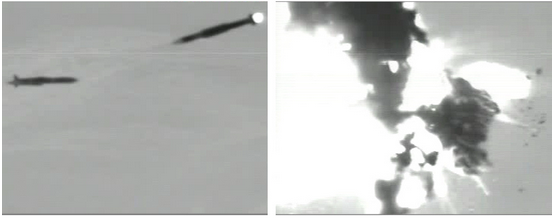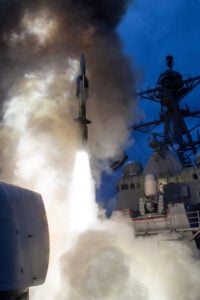Non-Standard: Navy SM-6 Kills Cruise Missiles Deep Inland
Posted on

A Navy SM-6 interceptor missile destroys a simulated cruise missile in an Aug. 14 test.
You wouldn’t expect the Navy to test its weapons in the desert. But that’s just what happened Thursday at White Sands Missile Range, New Mexico, an Army facility 500 miles from the sea, where a Standard Missile-6 successfully intercepted a mock cruise missile flying low and slow over land. Hitting that target is one sign of how far Navy missile defense programs have cast their net beyond their traditional domain.
The Navy’s Standard Missile is, as the bland name says, the Navy’s standard missile to defend the fleet against incoming strikes by enemy aircraft and anti-ship missiles. (Attacking enemy ships and ground targets is done by other missiles altogether). In recent years, though, the Raytheon-made missile has branched out. The standard Standard, the SM-2, is a straightforward fleet-defense weapon, with some capability to intercept targets over the land and even hit enemy ships. But the military is developing a long-range, high-altitude SM-3 variant to intercept ballistic missiles as they coast through space.
Then there’s the SM-6, first issued to the fleet last fall. “It’s the latest evolution of the Standard Missile family,” said Navy Cdr. Sidney Hodgson, the deputy program manager for the Standard series. (SM-4 and SM-5 never saw service). “It doesn’t replace the SM-2,” which will stay in service alongside the SM-6, he emphasized, but “it gives you increased firepower, it gives you extended range.”
To save costs, the Standard Missile Six is an unholy hybrid of the long-range rocket motor from the SM-3, the agile aerodynamic body of the SM-2, and the nose of an AMRAAM air-to-air missile, normally carried by fighter planes. It’s the borrowed AMRAAM components in particular that let the SM-6 pick out tricky targets like a cruise missile maneuvering at low altitude and low speed over land. Even in the desert, the land is never as smooth and flat as the sea, so a low-flying target can hide itself amidst the “ground clutter” of natural features — hills, rocks, buildings — that also show up on radar.
“What we were attempting to show was, [given] something that was subsonic, very low, could we discriminate and engage it?” said Raytheon’s senior program director for SM-6, Mike Campisi. “It was wonderful to see.”
The earlier SM-2 can intercept low-flying targets over land “in some scenarios,” Campisi told me, but that missile relies on the ship to continually “illuminate” the target with its radar. SM-6 has its own built-in targeting radar, more range, and much more capability to intercept a maneuvering target. It will also be able home in on a target too distant for the ship that launched it to detect, using data relayed from other ships or aircraft over the Navy’s future NIFC-CA battle network.
So, I asked Campisi, is there anything else in the US arsenal today that can intercept incoming cruise missiles as far away as the SM-6? His answer: “No.”

The USS John Paul Jones test-fires an SM-6 in June
That’s a big deal because cruise missiles have been a major headache since the Cold War. Salvoes of Soviet cruise missiles threatened to overwhelm the defenses of US Navy carrier battlegroups, and that’s a threat the Chinese have resurrected. The biggest threat to the US Pacific Fleet isn’t the PLA Navy, it’s the 2nd Artillery Force’s immense inventory of land-based missiles.
The Chinese DF-21 “carrier killer” ballistic missile has attracted a lot of publicity, but that’s still a nascent technology, while anti-ship cruise missiles (ASCMs) are long-established and battle-tested. Iran has shore-based ASCM batteries as well. Even the Lebanese militia Hezbollah managed to cripple an Israeli corvette in 2006 with what was probably an Iranian copy of the Chinese C-802 ASCM. The proliferation of anti-ship missiles is so severe that the Marine Corps must come up with new tactics and technologies to get from ship to shore, while the Navy is working with the Air Force on a new warfighting concept known as “Air-Sea Battle.”
So anything that kills cruise missiles at long range is a welcome addition to the US arsenal. But Campisi and Hodgson told me not to typecast the SM-6. It’s capable of killing both helicopters and fixed-wing planes, Hodgson said, both manned aircraft and drones, as well as missiles. Previous tests included at-sea launches against both low-altitude, subsonic targets and high-altitude, supersonic ones. All have been successful, Campisi said: “We’re 14 for 14 right now.”
Roughly a hundred SM-6 missiles have already been issued to the fleet — what’s called Early Operational Capability — for use with the “Baseline 7” version of the Aegis fire control system. The current series of tests are proving the missile’s compatibility with the latest Aegis upgrade, Baseline 9C, which can engage enemy aircraft and ballistic missiles at the same time. Overall, the latest tests are meant “to really stretch the envelope [against] a wide range of threat sets,” Campisi said. “We’ve always tried to make this a multi-purpose weapon.”
Such flexibility is tactically and logistically important, because Navy ships can’t afford to fill their limited number of Vertical Launch System (VLS) cells with special-purpose missiles for narrow missions that may or may not come up. In fact, the limited capacity to carry missiles is a major, if mundane, motivation for the Navy’s increasing investment both in electromagnetic rail guns, which fire 23-pound metal slugs, and in lasers, whose ammunition weighs nothing at all. But lasers can’t fire at targets beyond the horizon, and even rail guns will likely max out at 100 or so miles. That leaves longer-ranged engagements to missiles like the SM-6.
Subscribe to our newsletter
Promotions, new products and sales. Directly to your inbox.
